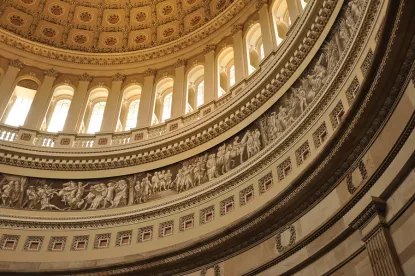President Biden. On January 20, 2021, Joseph R. Biden Jr. was sworn in as the 46th president of the United States. With the ongoing COVID-19 pandemic and security concerns arising out of the riot at the United States Capitol two weeks earlier, it was an inauguration like no other. Still, the ceremonies did not stop President Biden from getting to work right away, as on his first day in office he issued 17 executive orders, many of them impacting employers. We have more details here. As we discussed in our 2021 Labor and Employment Forecast, the new administration and 117th United States Congress will likely bring about significant changes to labor and employment policy in the coming weeks and months.
Robb Rolled. Shortly after being inaugurated, President Biden made National Labor Relations Board (NLRB) General Counsel Peter Robb quite an offer: resign within five hours or be fired (Robb’s term wasn’t scheduled to expire until November 2021). Robb, whose policies have drawn the ire of labor organizations, refused to resign, noting in a letter to Ambassador Cathy Russell, director of the White House Office of Presidential Personnel, that his removal “would set an unfortunate precedent for the labor relations of this country” because “the prosecution of violations of the [National Labor Relations Act] will now be subject to the political influence of the White House.” This didn’t convince President Biden, who subsequently terminated Robb’s employment. Traditionally, NLRB general counsels are permitted to serve out their terms during changes in administrations. Tom Davis has more on this unprecedented action, as well as a preview of labor law and policy in the Biden administration.
Ch-Ch-Changes. Besides firing the Board’s general counsel, President Biden and his administration did not waste time making additional changes at both the Board and the U.S. Department of Labor (DOL). For example, Lauren McFerran—the Board’s sole Democratic member—was named chair of the NLRB. Charlotte A. Burrows is now chair of the U.S. Equal Employment Opportunity Commission (EEOC). At the DOL, career official Al Stewart is now the acting secretary of labor and M. Patricia Smith—former solicitor of labor in the Obama administration—is serving as senior counselor to the secretary of labor. James S. Frederick, a former health and safety official for the United Steelworkers, serves as deputy assistant secretary of labor for occupational safety and health and leads the Occupational Safety and Health Administration (OSHA). Finally, Jenny R. Yang, former chair of the EEOC, is now the director of the Office of Federal Contract Compliance Programs.
U.S. Citizenship Act of 2021. President Biden made clear this week that one of his top priorities will be reforming the U.S. immigration system via the U.S. Citizenship Act of 2021. Senator Robert Menendez (D-NJ), who was a member of the “Gang of Eight” that helped pass immigration reform in the U.S. Senate in 2013, will be the lead cosponsor of the bill in the Senate. Linda Sánchez (D-CA) will lead the effort in the U.S. House of Representatives. While the text of the bill is not yet available, a summary released by the administration sets forth the main provisions of the legislation:
-
Path to citizenship and legal protections
-
Provides an eight-year path to citizenship for undocumented individuals
-
Permits DREAMers, temporary protected status (TPS) holders, and immigrant farmworkers who meet specific requirements to qualify for green cards immediately and apply for citizenship three years thereafter
-
Eliminates the so-called “3 and 10-year” reentry bars for individuals who accrue illegal presence in the United States but then leave in order to apply for their green cards abroad
-
Codifies work authorization for H-4 visa holders
-
Increases diversity visas from 55,000 to 80,000
-
-
Border management. The bill would improve infrastructure and technology to expedite screenings and detect contraband.
-
Address root causes of migration
-
Provides economic assistance to Guatemala, El Salvador, and Honduras to address corruption, alleviate poverty, and curb violence
-
Improves immigration courts by reducing backlogs and expanding training for immigration judges
-
Regulatory Freeze. Following President Biden’s inauguration, White House Chief of Staff Ron Klain issued a regulatory freeze memorandum. The memorandum instructs heads of executive branch agencies to withdraw pending final rules that have not yet been published in the Federal Register. This includes the U.S. Citizenship and Immigration Services’ (USCIS) modified “Strengthening the H-1B Nonimmigrant Visa Classification Program” final rule, as well as its biometrics rule. The freeze also indefinitely postpones the effective dates of the DOL’s recently finalized independent contractor regulation, as well as the EEOC’s conciliation regulation, which have both been finalized but haven’t become effective.
Biden’s Relief Plan. President Biden also issued his “American Rescue Plan” to address the COVID-19 pandemic in the United States and boost the U.S. economy. The $1.9 trillion proposal continues many programs that we have seen as part of the Families First Coronavirus Response Act (FFCRA) and the Coronavirus Aid, Relief, and Economic Security (CARES) Act, in addition to including new provisions. The plan would provide individuals with $1,400 relief checks and extend and expand FFCRA leave provisions through September 2021, with the following changes:
-
The emergency leave mandate would apply to all employers—the 500-employee threshold and 50-employee small business carve-out would be eliminated.
-
Employers would be required to “provide over 14 weeks of paid sick and family and medical leave.”
-
Leave would be available to healthcare workers and first responders, who were exempt under the FFCRA.
-
Tax credits would still be available for employers with fewer than 500 employees.
The plan would also extend CARES Act unemployment insurance programs through September 2021, including:
-
the Pandemic Emergency Unemployment Compensation (PEUC) program, which provides additional weeks of unemployment insurance benefits to individuals who have exhausted their state unemployment benefits;
-
the Pandemic Unemployment Assistance (PUA) program for workers who are not traditionally eligible for unemployment insurance (such as independent contractors); and
-
the Federal Pandemic Unemployment Compensation (FPUC) program, which would increase the $300-per-week unemployment insurance supplement to $400 per week.
In addition, the plan would:
-
immediately raise the federal minimum wage to $15 per hour and eliminate the tip credit;
-
authorize OSHA to promulgate a COVID-19 emergency temporary standard that would “cover[] a broad set of workers,” including state and local public employees who are not covered by OSHA; and
-
provide $50 billion in grants and loans for small businesses, $20 billion for a national vaccination program, $50 billion for testing, and $130 billion to help schools reopen safely.
Of course, many of these provisions will be politically unpopular with Republicans and the last round of COVID-19/stimulus relief took months to negotiate (yes, it was a different Congress and an election year, but still …). Without nuking the legislative filibuster, it could be a challenge for Democrats to get this package, as written, passed quickly. Alternatively, Democrats could consider using an arcane budget tool called “reconciliation” that would allow them to pass the bill with 51 votes, though the process has rules that may require Democrats to make changes to the legislative package.
EEOC Changes Litigation Protocols. Effective January 13, 2021, the U.S. Equal Employment Opportunity Commission voted (3-2) to modify its delegation of litigation authority. Over the years, much of this authority had been ceded to the general counsel. This ruffled feathers in the business community, which argued that much of the litigation authority should be retained by the Commission itself (as set forth in Title VII of the Civil Rights Act of 1964) in order to ensure consistency of enforcement policies and provide better accountability. In March 2020, the Commission took steps to reclaim much of this authority. Now, the EEOC adds to these changes by requiring the general counsel to submit all requests to commence or intervene in litigation to the Commission.
An Oath So Nice, You Gotta Say It Twice. Thankfully, despite the aforementioned safety protocols, President Biden’s inauguration went off without a hitch this week. President Obama wasn’t so lucky during his inauguration in 2009. He and Chief Justice of the United States John G. Roberts Jr. stumbled over the prescribed words of the constitutionally required oath of office, which directs the president-elect to say:
“I do solemnly swear that I will faithfully execute the Office of President of the United States, and will to the best of my ability, preserve, protect and defend the Constitution of the United States.”
But Chief Justice Roberts mixed up the words and prompted President Obama to say:
“I will execute the Office of President to the United States faithfully.”
Out of an abundance of caution, the two redid the oath of office the following day at the White House. It may seem minor, but because the oath is the only constitutional protocol that must be followed before the president assumes office, it is better to be safe than sorry.




 />i
/>i

